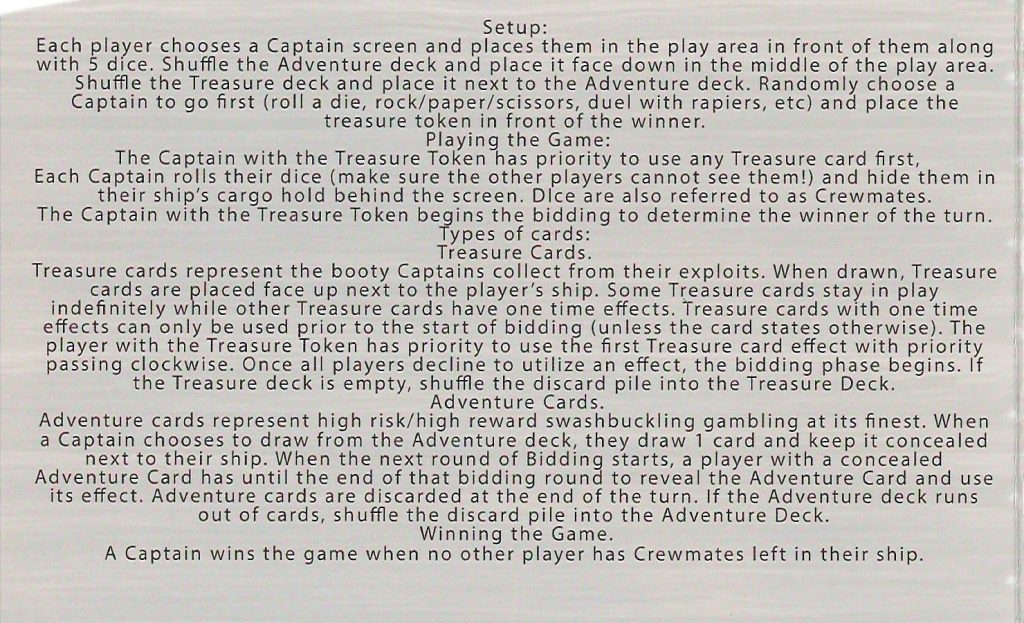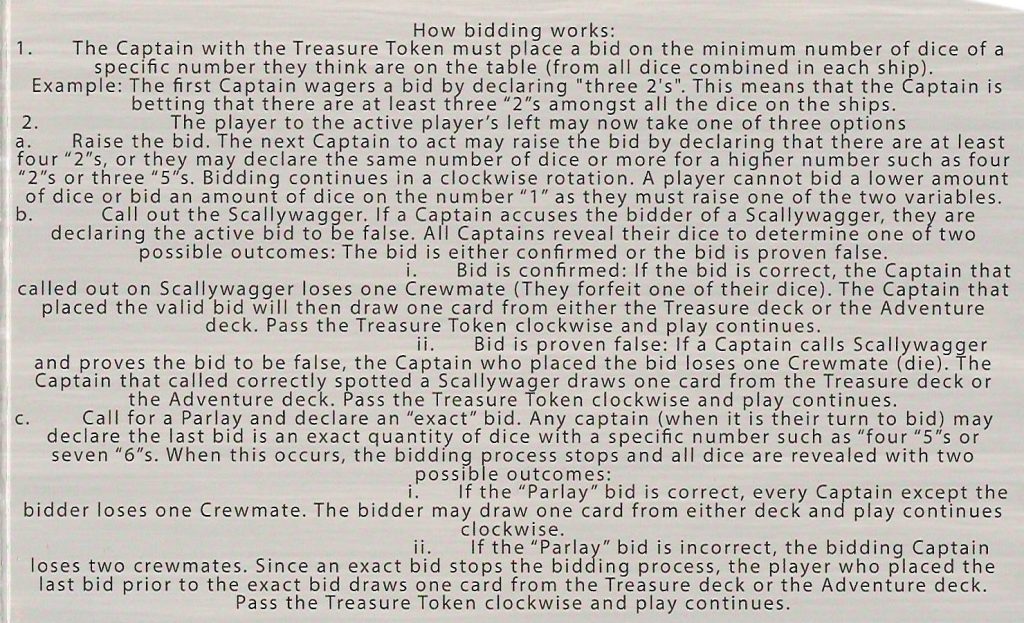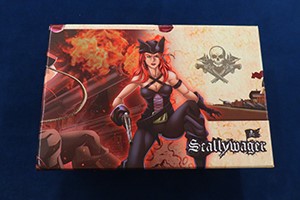
“Have you ever played Liar’s Dice?“
Sitting down for a demo of Scallywager at Origins in the SRG open play area, this was the first question I was asked. I hadn’t (weird in hindsight, I know), so I sat down not fully certain of what I was getting into.
It did not take long for me to realize the fun of the game (winning the demo didn’t hurt), and as I didn’t have anything like it on my board game shelf, I bought a copy on the spot.
Pretty good endorsement, right? But you’re here to see why this game is good, so let’s start with the rules, or you can watch our stream of the game below!
Scallywager Game Rules – How To Play
Player Count: 2-5
Estimated Play Time: 15-30 minutes
Scallywager Rules PDF
The rules fit nicely on two pages, and you’ll find them on the back of every player’s Captain screen, so everybody will have a copy they can reference throughout the course of the game. The text is a little small, so we’ve got the images for you below as well.
Scallywager Setup
Give each player a Captain screen and 5 dice (d6s) of the same color. Shuffle the Treasure and Adventure decks and place each face-down in the middle of the table where everyone can easily reach them. find your favorite random way to determine first player, place the treasure token in front of them, and you’re ready to begin!
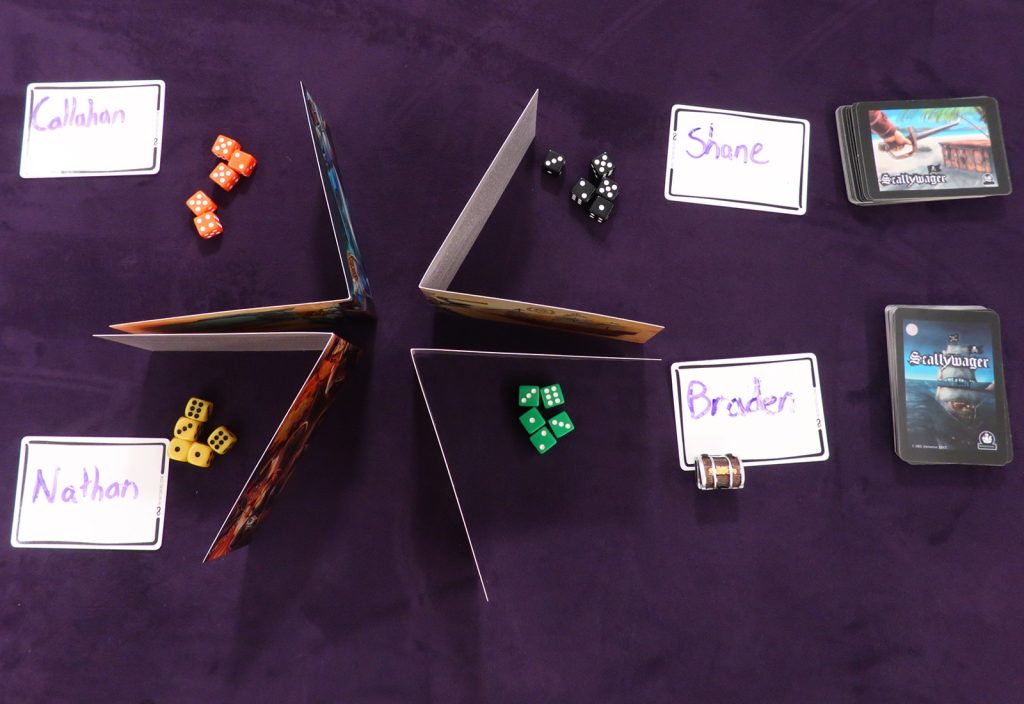
Scallywager Gameplay
Each player will take their 5 dice (crewmates) and simultaneously roll them behind their Captain’s screen, taking care to keep their dice rolls secret from everyone else. The player with the Treasure Token will then make the opening bid.
A bid in Scallywager is simple – you state the number of dice that rolled a specific die face you believe is hidden in total behind all players’ screens. For example: two 1s, three 6s, etc. The next player (clockwise) must then either raise the bid, parlay, or call the previous bidder a Scallywagger (not to be confused with Scallywager, the name of the game).
- To raise a bid, you must either call the same quantity of a higher die face (moving from two 1s to two 4s) or a higher quantity of dice of any die face (moving from three 6s to four 1s). Think of the die quantity as the 10s place of a two-digit number, and the die face as the ones place – your total number must always go up.
For example: Two 3s is 23. You can’t bid two 2s, because that’d make your number 22, but you can bid two 4s (24) or three 2s (32). - If you call the previous bidder a Scallywagger, you are stating that you believe they have overbid. For example, if they bid 5 6s, you believe that there are fewer than five 6s across all players’ dice.
- When you parlay, you are stating that you believe the previous bid is exactly correct.
Since you can only see your own dice, you’ll be using the information from your dice roll, the laws of probability, previous bids, and even player psychology to make educated guesses on whether a bid seems legitimate.
Accusations and parlays are dangerous things on a pirate ship though. By invoking one of these game actions, you are risking the lives of your crewmates (your d6s) on the outcome.
After calling the previous bidder a scallywagger, all dice are revealed. If you correctly deduced that there aren’t enough dice to fulfill their bid, they lose a crewmate. If the revealed dice show at least as many die faces as the previous player bid, you lose a die instead.
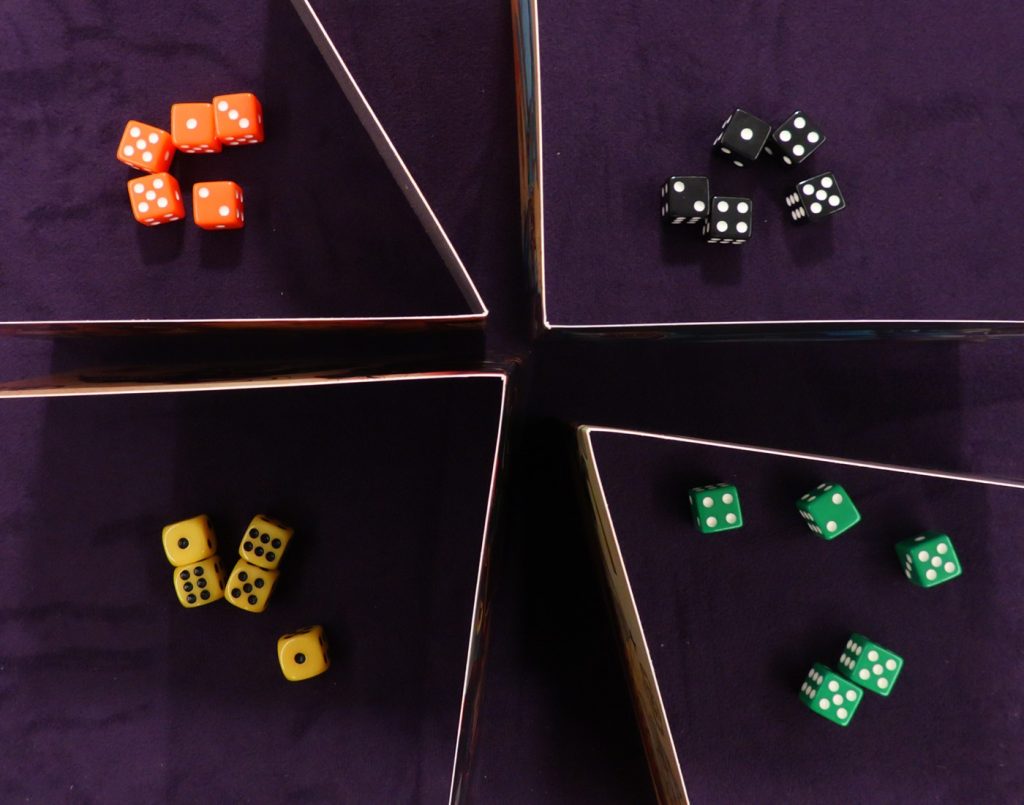
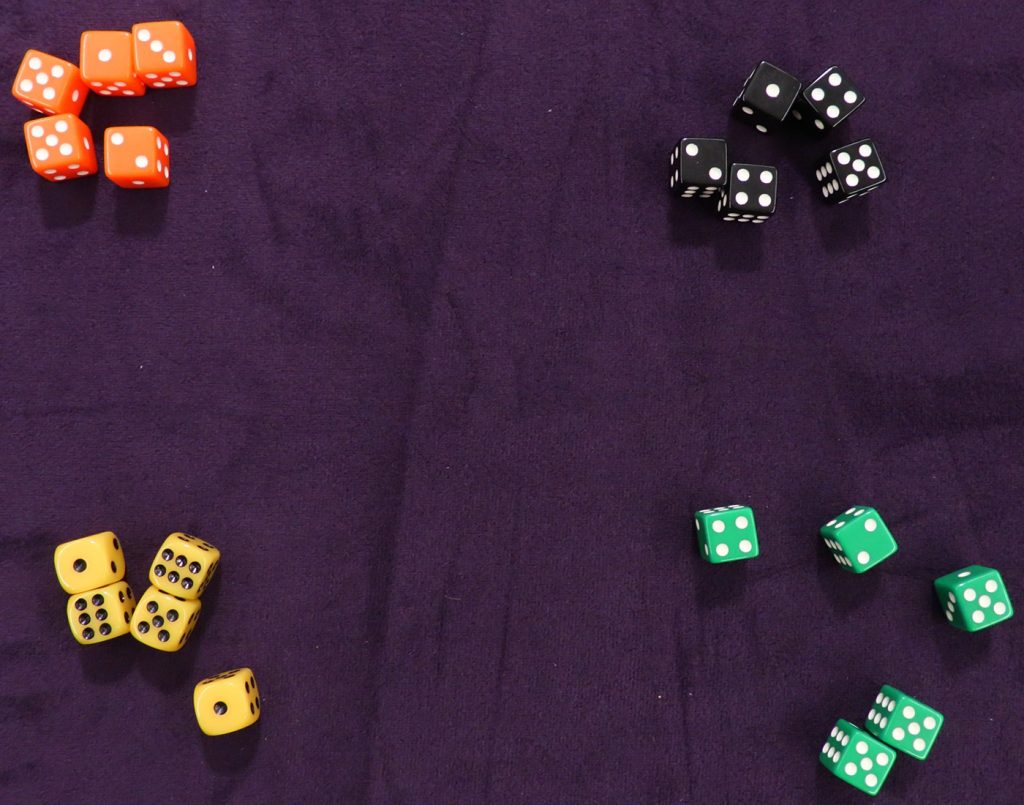
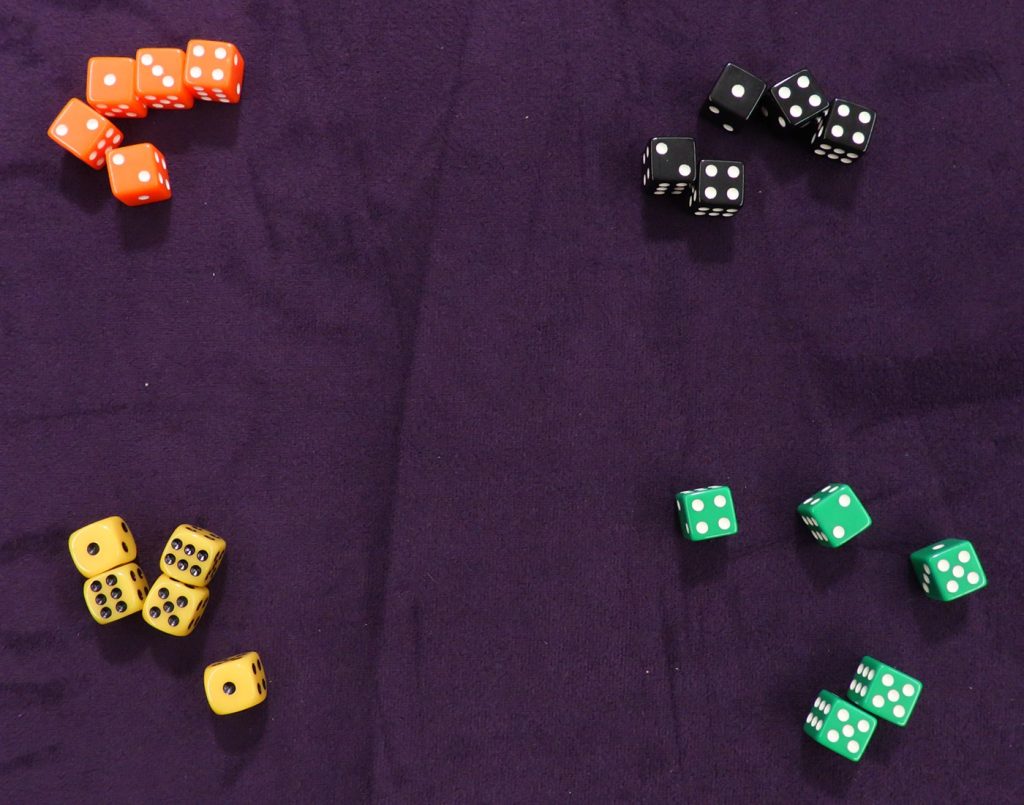
When a parlay is called, all dice are revealed. If the person who called the parlay reveals the exact bid of the last bidder, each other player loses a die. If they’re over or under the bid, however, the player who called for the parlay loses two dice instead of the normal one.
The player on the winning side of a parlay or accusation then gets to draw one card from either the Treasure deck or the Adventure deck, and the treasure token passes to the next player on the left.
Treasures are revealed when drawn, and will either offer a continuous effect or a one-time effect. One-time effect treasures may only be used before bidding starts for a round (unless their text states otherwise), and the order in which players may use them starts from the player who holds the treasure token and proceeds clockwise.
Adventures are drawn face down, and their activation timing can vary. Unlike Treasures, which stick around indefinitely, Adventures must be used during the next round of bidding. If a player with an Adventure chooses not to use it, it is discarded at the end of the round.
How To Win Scallywager
Your goal is to be the last person with any crewmates! This is often easier said than done, however, as fewer dice will be getting rolled as the game progresses, making bids trickier to navigate. This is especially true if you lose more dice than your opponents early, as you’ll have less information to work with than they do.
That said, a good pirate always has a trick their opponents won’t be expecting, so here be a few strategies to ensure yer enemies be walkin’ tha plank!
Always Be Mindful Of The Odds
When rolling a d6, you’re going to have an equal chance to get one of six results: 1, 2, 3, 4, 5, and 6. This means each die behind your opponents’ boards has a 1 in 6 chance of being the number you need for your bid, so for every six dice still in the game, there will be a 1, a 2, a 3, a 4, a 5, and a 6 on average.
On average is the key phrase here – get 20-30 dice in play, and there will be an absolute ton of variance in what everybody rolls each round. So while 1 in 6 is a good baseline, you’ll need to supplement that knowledge with a few extra tricks.

Pay Attention To Your Opponents’ Bids
Unless they’re bluffing, the amount and type of dice your opponents bid will give you some insight as to what dice they’re hiding behind their screen. For example, an opponent who consistently bids quantities of 5s is probably holding 2 or 3 of them at minimum, trusting in the law of averages to see them the rest of the way through a bid with their opponents’ dice.
Avoid Losing Dice Early
Unlike many games, where taking an early lead only puts a target on your back, having more dice than your opponents gives you more information than your opponents.
For example, if you have four dice while your three opponents have two apiece (ten dice total in play), you know 40% of the dice pool while each other player only knows 20%. That is an incredible advantage when deciding how to bid, making you at least twice as likely to make an accurate bid (assuming the skill level of each player is relatively equal).
I say at least, because you can boost your ability to measure a bid’s quality using the other tips in this section, which can tilt the odds even further in your favor in many scenarios. Naturally, this means if someone takes an early lead, it is often more difficult for another player to take it back than it is for a savvy player to maintain it.
Be Aggressive With Your First Bid Where Possible
When we first started playing Scallywager, bids at the beginning of a round started small. One 2, then one 4, followed by two 3s, etc. After playing for a bit, we figured out that if you started the bid higher (three 4s, four 6s, etc.)you could put the next player or two in a difficult position.
This is because you’re removing the “safe” option of raising the bid to something plausible, which often forces someone to rely on luck to guess their way out of a seemingly no-win scenario. Sometimes, the next player in line will know a crucial piece of info you don’t and be able to pass the issue to next player instead, which is often still to your benefit.
There are two potential drawbacks if you aren’t careful though. First, if the bidding circles back around to you, you’ll almost certainly be the one in a bind. Second, you want to be the one to force an opponent to call you a scallywagger or declare a parlay, because Treasure and Adventure cards can often change the state of the game in a big way.
If an opponent takes advantage of your opening bid and passes the no-win scenario to another player, you’ll still get to keep your dice, but one of them will be getting that coveted payoff instead.
Prioritize Early Treasures and Adventures
We’ve talked about Treasure and Adventure cards a fair bit, but we haven’t actually shown you any. Let’s fix that.
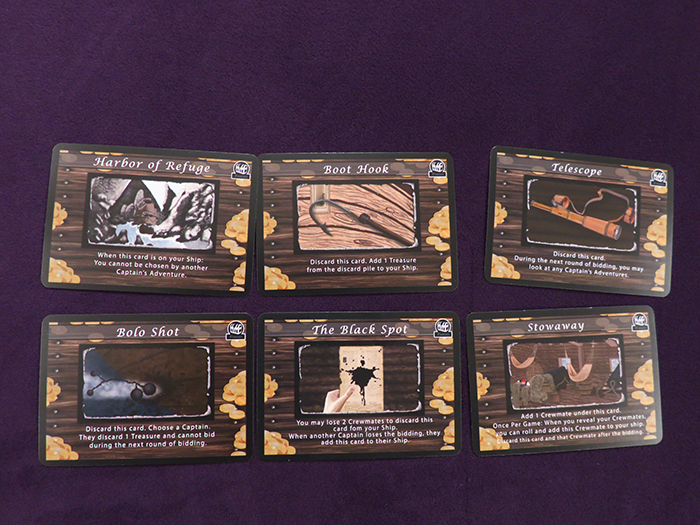
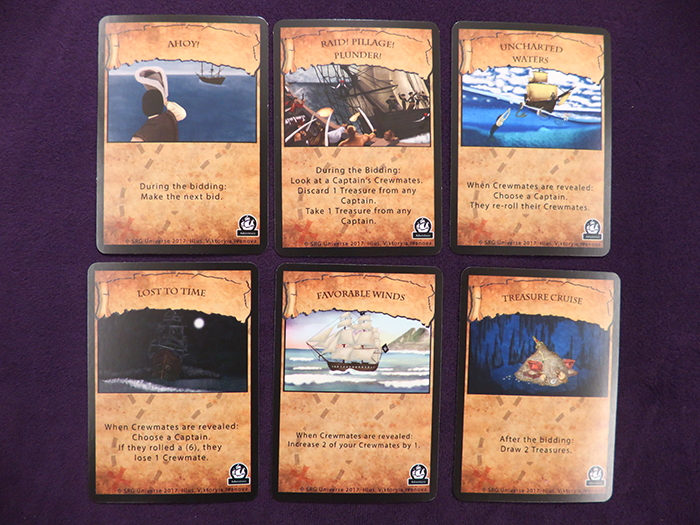
When you successfully call someone out as a scallywagger or fend off a false accusation, you are allowed to draw one card from either the Treasure deck or the Adventure deck. We’ve found that Adventures skew toward being very slightly more powerful, but honestly, you can’t go wrong with either set of cards.
These cards are great for ferreting out extra information, stealing or killing others’ crewmates, messing with bids, protecting yourself from other players, and more, so the more of them you can snag early, the less likely ye be to walk tha plank!
There is one card you don’t want to draw though – The Black Spot from the Treasure deck. It doesn’t look all that dangerous up front, but there are cards in both decks that can do you major harm if you’re unlucky enough to be holding it when they come out. Like, cripple you or kick you out of the game type of harm.
Or it might do nothing – maybe those cards don’t come out and it just hangs out on the open sea. With you. Is it going to strike? Is it cool? You won’t know until the game is over.
If this kind of pressure isn’t for you, getting rid of The Black Spot is possible, but prohibitively expensive in the mid to late game (2 crewmates is a HUGE ask). So if you plan to dump it, do so sooner than later – you might not have the resources if you wait.
That said, it’s usually better to let the losing end of the next bid take it off your hands – you get rid of something awful for free, and all you have to do is not lose a future bid once it’s gone.
What could go wrong?
Is Scallywager A Good Game?
For those who like Liar’s Dice, I think you could definitely do worse than this reskinning of that classic game. The Treasures and Adventures add some variance and replayability, it’s got a reasonable balance of strategic depth in learning how to bid and read people, and it’s extremely satisfying to trap someone in a difficult situation during bidding.
And Scallywager has pirates!
The components and cards are well designed and reasonably durable, and Scallywager is also a game you can play with kids of most ages – it’s even a good way to teach them about probability if they’re working on it in math class!
I will say that $25 is a hefty price tag for what comes in the box – as fun as the novelty pirate hat has been to wear during streams, I would generally expect a game like this to fall in the $15-20 range in less turbulent economies since its components are dice, cards (on admittedly nice cardstock), a treasure token, and a few foldable (though durable) paper screens.
In 2025, however, I think it’s a fair and reasonable price under the circumstances. Barely, but the tariffs on board game components are no joke, so players and game companies are going to be in this together until things settle down again. So pick up a copy from SRG and prepare to set sail for adventure – ye won’t be sorry!
Other Board Game Articles You’ll Love:
- How To Play Project L
- How To Play Tiny Epic Galaxies
- Why Are They Called Meeples?
- Godsforge Board Game Review
- Axe-A-Lot-L Card Game Review
- Blokus Strategy Guide
Braden is a founder of Assorted Meeples and has been a gamer & writer with a vivid imagination all his life. Don’t believe us? Check out his excitement when meeting Goosebumps author R.L. Stine as a kid! An avid Magic: The Gathering spellslinger for over 15 years, you can always convince him to shuffle up for a game (or three!) of Commander.

